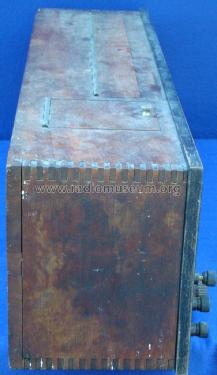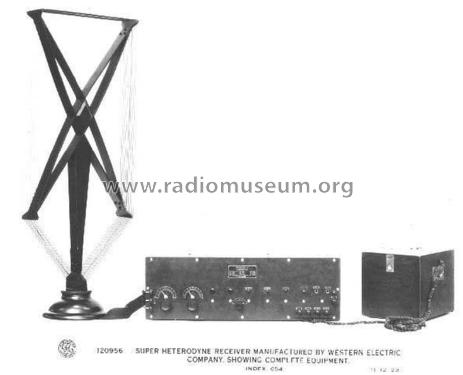- Country
- United States of America (USA)
- Manufacturer / Brand
- Western Electric Company Inc.; New York (NY)
- Year
- 1922
- Category
- Broadcast Receiver - or past WW2 Tuner
- Radiomuseum.org ID
- 222014
- Number of Tubes
- 7
- Main principle
- Superheterodyne (common); 2 AF stage(s)
- Wave bands
- Broadcast only (MW).
- Power type and voltage
- Dry Batteries
- Loudspeaker
- - This model requires external speaker(s).
- Material
- Wooden case
- from Radiomuseum.org
- Model: 4-A - Western Electric Company Inc.;
- Shape
- Tablemodel, Box - most often with Lid (NOT slant panel).
- Dimensions (WHD)
- 26.75 x 8.75 x 6.75 inch / 679 x 222 x 171 mm
- Notes
- Western Electric 4-A Superheterodyne Receiver designed by Harald Friis. During his career with the Bell System, Harald Friis contributed substantially to almost every aspect of the radio art. His earliest work was on vacuum tube efficiency. He then worked on ship-to-shore radio reception. In the early twenties he built the very first field measuring set, for the 300 to 400 meter range. He also designed the first commercial double-detection or superheterodyne radio receiver, the Western Electric 4A receiver. Double detection means that there are two "Detector" stages: the first one is the mixer (of signal and oscillator frequency), the second one is for demodulation.
- Mentioned in
- Radio Manufacturers of the 1920's, Vol. 3 (Page 232)
- Author
- Model page created by Alan Larsen. See "Data change" for further contributors.
- Other Models
-
Here you find 171 models, 149 with images and 32 with schematics for wireless sets etc. In French: TSF for Télégraphie sans fil.
All listed radios etc. from Western Electric Company Inc.; New York (NY)

















